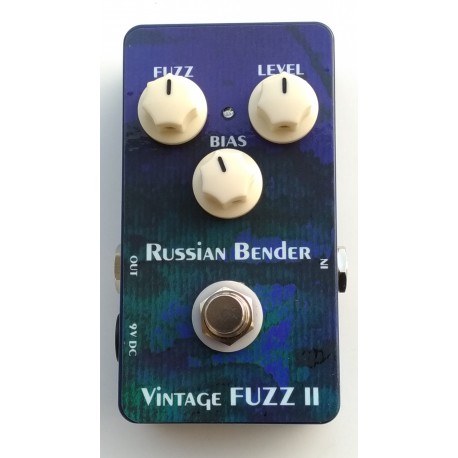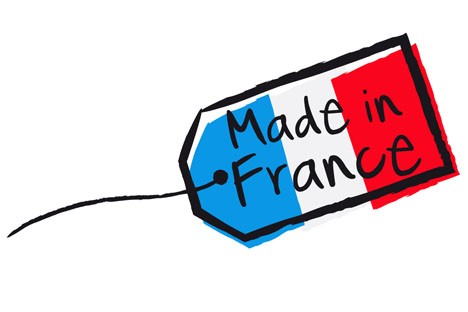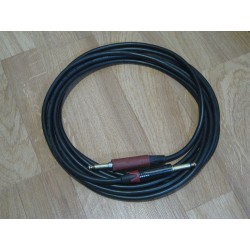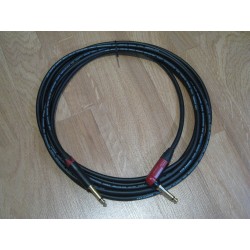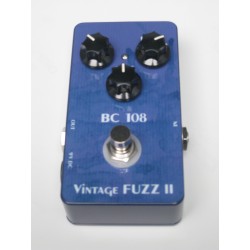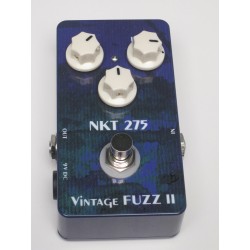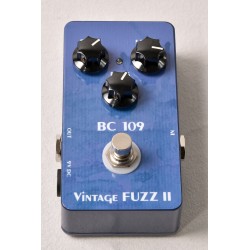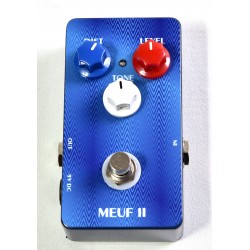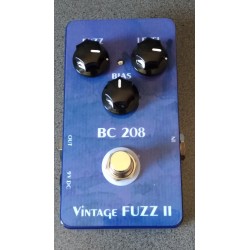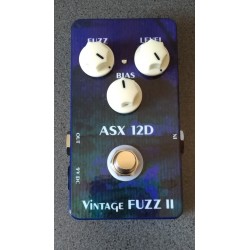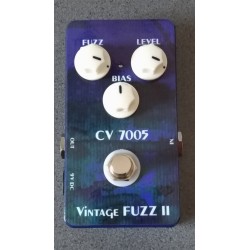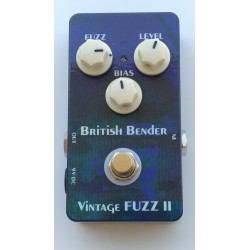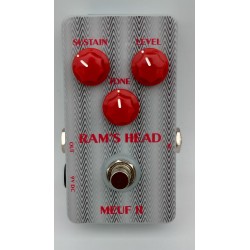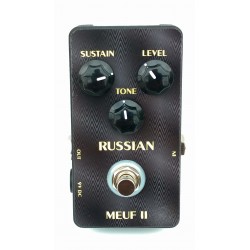Aucun produit
VINTAGE FUZZ 2 RUSSIAN BENDER
P-686-025
Neuf
La fuzz 3 transistors Germanium (Colorsound Tone Bender MKII) revue par le Doc...
Transistors Russes germanium NOS MP41 (datés de 1978), le son LED ZEPP, STONES, WHO au bout des pieds …
1 Article
En stock
En achetant ce produit vous pouvez gagner jusqu'à 15 points de fidélité. Votre panier totalisera 15 points de fidélité pouvant être transformé(s) en un bon de réduction de 7,50 €.
- Retirer ce produit de mes favoris
- Ajouter ce produit à mes favoris
- Imprimer
En savoir plus
Certainement le modèle de fuzz le plus emblématique caractérisée par son son lourd et sa capacité à partir en larsen.
Ajout d'un réglage de bias permettant de gérer l’attaque et l’agressivité.
Boitier HAMMOND 1590B en aluminium assurant le blindage de la carte électronique.
Composants audio (résistances carbone, condensateurs Panasonic FC et Wima).
Circuit imprimé double face trous métallisés avec plan de masse recto et verso.
Vrai bypass, jacks Neutrik, potentiomètres Alpha 16 mm.
Grâce à son inverseur de tension interne la Vintage Fuzz peut être alimentée depuis un bloc d'alimentation 9V DC à sorties isolées ou non.
La pédale est protégée contre les surtensions et les inversions de polarité.
Depuis 2020 le voyant LED de fonctionnement est intégré au switch et apporte une touche de modernité.
Alimentation externe 9 V DC standard (non fournie) (négatif au centre).
Consommation de l'ordre de 8mA.
Taille: 113 x 67 x 48mm Poids : 235g

Hand Made In FRANCE by DOC MUSIC STATION
Avis
Sacrebleu ! Sacrée pédale bleue..
Cela faisait déjà plusieurs années que je lorgnais du côté des réalisations du Doc. Je cherchais une fuzz polyvalente mais avec du caractère. J'ai profité de mon passage au Festival Guitare d'Issoudun pour tester et concrétiser mon envie. Soit dit en passant, Denis sait mettre en valeur ses réalisations sur trois pedalboards : une présentation sobre et efficace. A cela, s'ajoute une discussion amicale mais aussi technique en ce qui concerne les petites boites. La Fuzz Russian Bender que j'ai choisie est sobrement mais magnifiquement réalisée avec des transistors germanium sélectionnés. Les sons sont superbes et elle réagit très bien au potard de volume de la guitare. On baisse, ça cleane merveilleusement et quand on pousse le volume, ça crunche, ça mord, bref c'est beau ! Merci donc à Denis pour le sérieux de son travail, son écoute, ses conseils et sa gentillesse. DocMusicStation c'est de la bombe !
Dark Classic & Thick
SOUND:
https://www.youtube.com/watch?v=xHtiFZ5XvYM
An outstanding job replicating that classic 1960s and into the 1970s heavy, thick fuzz sound, you can’t go wrong with the Vintage Fuzz II. With the Fuzz level up full you do not get that thin searing sizzle you hear from some more modern-day counterparts, but a slight breaking up quality that places the Vintage Fuzz II into the category of part fuzz, part distortion and part overdrive. As you turn back (reduce) the Fuzz level it produces a more distorted and thicker quality, which is even more obvious as you adjust the Bias level for a more stabbing or bubbling effect to the tone’s quality. And once you crank out some heavy riffs you can hear the emergence of early Black Sabbath and dark Metal. What makes the Vintage Fuzz II so useful is that it cleans up so nicely when you dial back your guitar’s volume. You can put the Fuzz level up high and get that famous vintage fuzz tone, but as you ease off on the guitar’s volume it sounds more crunchy and distorted… and without losing too much overall volume in the process. It sounds awesome on a clean amp channel (with a hint of gain), but works very well and adds a new dimension to a high-gain channel’s tone. When doing so, I found it best to ease off on the amp’s gain and then add in the Vintage Fuzz II at only quarter way on the Fuzz level for a huge sound.
OVERALL IMPRESSION:
Developed by Doc Music Station (France), Vintage Fuzz II (MP 41 MK 2 model) produces that classic hard-hitting fuzz tone at a fair price of 159 Euro. Denis (the designer of the Vintage Fuzz II) refers to this pedal as a Tone Bender, powered with three Germanium Russian NOS MP 41 transistors to help you attain the tones of Led Zeppelin, The Who and The Rolling Stones. I also hear quite clearly some Black Sabbath in the mix. The Fuzz knob on its own makes it sound great, and anywhere from a heavy breakup to a grainy sizzle (with a heavy sound that easily enters the feedback zone), but you can really makes some awesome tone changes in the attack and aggression by adjusting the Bias knob. This is one of the best fuzz pedals I have tried that actually mimics that early fuzz tone and is unlike many of the ‘modern’ fuzz pedals out there. Used with a clean amp or very carefully and sparingly with a high-gain amp, there is a ton of tonal options available, particularly as you adjust your guitar’s volume knob.
EASE OF USE:
The Vintage Fuzz II allows you to dial into somewhat smooth tones to thick and heavy tones. When you turn the Fuzz level all the way up, the tone becomes more saturated and smoother. However, even up full you get a nice grain and edge, while not being a smooth as more modern-day fuzzes (which is why this is a ‘Vintage’ Fuzz). As you dial back the Fuzz level it takes on more of a distorted or over-driven sound, which makes it less fuzz-like and, consequently, more diverse. Certainly there is some fuzz quality when dialed back, but it simply sounds edgier like a Fender Bassman amp being pushed to the limits. The Bias control, likewise, either keeps the signal smoother (turned all the way clockwise) or rougher around the edges with a stabbing quality (turned all the way counter-clockwise). The Level merely controls how loud the signal is, although the tone becomes more hardcore when you push the Level past 1-o’clock. Those three controls then need to be coordinated a bit, since as you increase Bias aggression the volume does increase. As you increase the Fuzz level the volume also increases (although it tends to stabilize around 1-o’clock). And, obviously, as the Level increases so too does the overall volume. The other minor coordinating factor is whether you adjust your guitar’s volume knob, since doing so does produce a different tone (besides affecting volume somewhat) and will affect the fuzz quality or characteristics.
RELIABILITY & DURABILITY:
Weighing 230g (8oz) and measuring in at 113 x 67 mm (about 4.25 x 2.25 inches), the Hammond 1590B aluminum case is both lightweight and provides shielding of the electronic card. The plastic knobs feel of good quality, and when turned the pots feel both solid and smooth in quality. The audio components comprise of carbon resistors, Wima silver mica capacitors, and the Vintage Fuzz is protected against over-voltage and reverse polarity. The cable input/output both are located on the sides, as well as the power supply insert (standard 9v 2.1 mm), and so there is minor concern with stomping and hitting any of the inputs/output. This true bypass pedal also has Neutrik jacks and Alpha 16mm faders for the Gain, Volume and Tone pots. The footswitch is somewhat close to the Bias knob, but that knob is of a good quality, and so any slight stomping pressure on the Bias knob should not pose any concern. The LED on/off light is small and well protected by the three knobs.
Une chouette expérience
Débarquer à Compiègne avec un sax et un pedal board, essayer 16 pédales de qualité incroyable et repartir avec une bébête truffée de puces russes après 2h d'échanges passionnants, que du bonheur ! Et ça sonne grave !
- 1 personne(s) sur 1 ont trouvé ce commentaire utile.
Une tuerie
Merci pour l'envoi très rapide.
J'ai bien fait d'attendre et de suivre vos conseils pour brancher la pédale sur une alimentation adéquate.
Le son est extraordinaire, du pure vintage façon Mick Ronson et autres et un sustain sans limite....
Petit conseil à Doc Station: que le site présente un exemple de son avec chaque pédale (avec 2 -3 réglages) sur la base d'un son clair (comme le fait ProGuitarShopDemos sur YouTube). Car j'ai hésité quand je n'ai pas trouvé de démo. Mais je ne regrette rien. J'ai été conquis. Bravo !!!!!
Cordialement
JMarc
- 1 personne(s) sur 1 ont trouvé ce commentaire utile.
Accessoires
12 autres produits dans la même catégorie :
Les clients qui ont acheté ce produit ont également acheté...
-
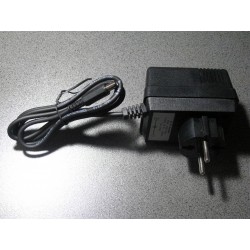
ALIMENTATION...
Alimentation 9V DC régulée, compatible avec...
21,00 €
-
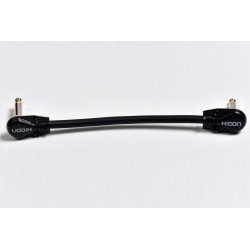
CABLE PATCH
Câble de haute qualité câblé en masse flottante...
10,10 €
-
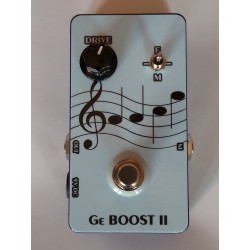
GE BOOST 2
Le GE BOOST 2 est un treble booster basé sur le...
159,00 €


